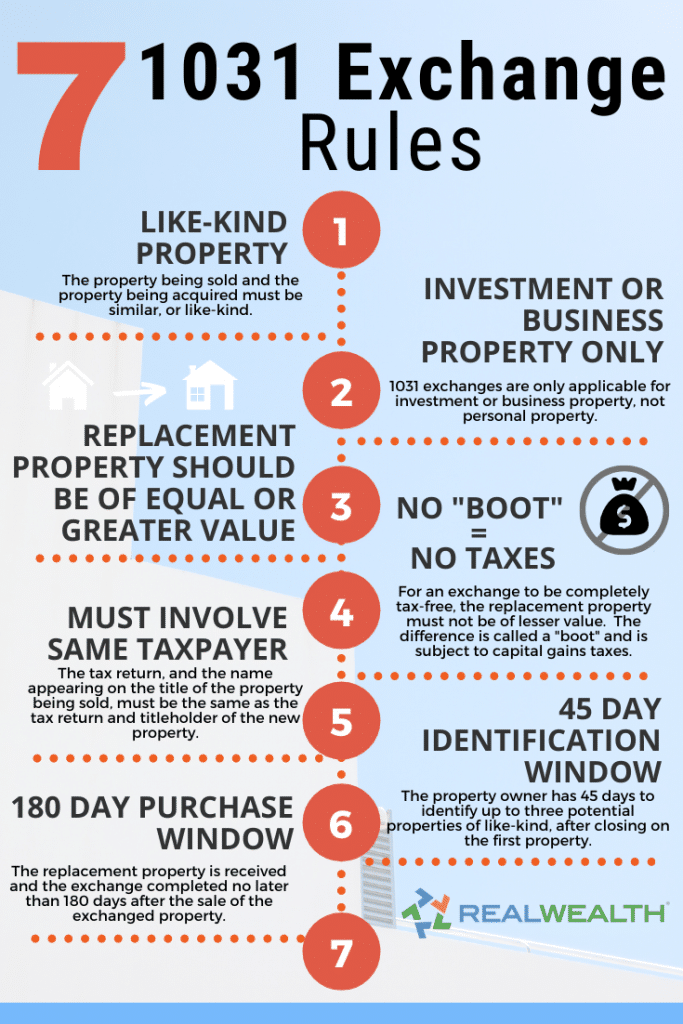Table of Contents
1031 Exchange Minnesota Rules – 1031 Exchange Rules 2021 is a real estate term that refers to the swap in investment residential property in order to defer taxes of capital gains. The name is gotten from Section 1031 of the Internal Revenue Service code, which describes financiers, real estate professionals, and title companies.
There are plenty of vibrant parts within Section 1031 that important to be understood before you attempt to utilize them. Exchange can be done only for “like-kind” residential properties and also the uses are restricted for vacation residential properties by IRS.
What Are 1031 Exchange Rules?
As stated in prior, 1031 exchange is an act of swapping investment properties. It is likewise frequently referred to as Starker or like-kind exchange. Most of swaps are applicable for taxes as sales, however you may defer tax or approved with restricted tax obligation if you can fulfill the 1031 exchange’s needs.
As the outcome, according to Internal Revenue Service, you will certainly be able to alter the investment types without the financial investment being identified as capital gain or being cashed out. This allows the investment go on being deferred from tax. 1031 is primarily can be done for infinite quantities of times. You would certainly be qualified to topple your real estate investment’s gain from one to one more, and afterwards to another, and afterwards to another. You might not gain profit from every swap, however you will stay clear of tax until the investment is marketed, even if it takes years later. If whatever works out as the system is planned out to be, after that you only need to pay a single tax at a 15% or 20% price of capital gains in long-term, depends upon your revenue. If you’re classified as taxpayers with a lower earnings class, it can even be 0%.
The 1031 Exchange Rules 2021 is used for the residential or commercial property of company and investment only. It may be able to use to the major home property under some problems. It is likewise really feasible to use 1031 for vacation properties, however the possibility is so low now compared to long times back.
What Are Types of 1031 Exchange Rules?
Simultaneous
Simultaneous exchange happens is the like-kind exchange happens within the very same day. This is the original 1031 exchange form until the regulation of taxes is upgraded to enable the opportunity for various other types.
Delayed
Delayed exchange happens if you sell the residential or commercial property, receive cash, and purchase another residential or commercial property by hold-up. The delay may take place for a single day to a couple of months before you finally obtain the substitute residential or commercial property. If the substitute property is not acquired within the Internal Revenue Service’ determined period, after that you need to pay your property sale’s capital gain.
Improvement
Likewise referred to as building and construction exchange, Improvement exchange occurs when you want to utilize tax-deferred cash to improve the substitute property. Nevertheless, the cash is kept by the middle man.
Reverse
Reverse exchange happens if you buy the residential or commercial property first, and then exchange it later on. In this situation, you need to purchase the replacement residential or commercial property initially then organize the 2nd residential property’s sale. This kind of exchange is not truly typical to be utilized, since the deals need to be entirely in cash money.
Delayed Exchanges and Timing Rules
There are 2 timing rules that basics and need to be observed throughout the Delayed exchanges:
45-Day Rule
The rule is related to the appointment of the substitute property. The middle male should obtain the money once the residential or commercial property transaction occurs. You need to not get the cash money as it’ll break the 1031 exchange.
Within the period of 45 days after the residential or commercial property is offered, the replacement residential or commercial property have to be designated to the middle man, and also the residential or commercial property that you want to get need to be specified. According to IRS, you might mark as much as three properties, as long as you neighbor to among the 3. It’s even possible to designate beyond three residential properties if they consult with particular evaluation examinations.
180-Day Rule
The timing rule associates with closing in the context of a Delayed exchange. The new residential or commercial property must be closed in the period of 180 days after the old is sold.
IRC Section 1031 Fact Sheet PDF
 Loading...
Loading...
HOPE THIS ARTICLE HELPS YOU!
IF YOU ARE STILL HAVING PROBLEM OR CONFUSED ABOUT [KEYWORD], YOU MAY CONSULT WITH A TAX EXPERT THROUGH THIS LINK OR WITH A FINANCE EXPERT THROUGH THE CHAT BOX RIGHT BELOW.
